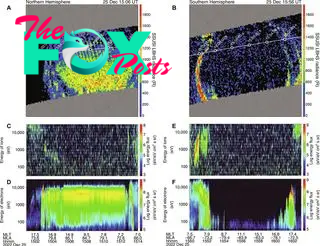Science
Rare 'polar rain' aurora seen from Earth for the first time
A remarkably smooth and puzzling Christmas Day aurora observed over the Arctic in 2022 was the result of a 'rainstorm' of electrons direct from the sun, says Japanese and US-based researchers.
It is the first time that a rare aurora of this kind has been seen from the ground, and it came at a time when the gusts of the solar wind had almost completely dropped off, leaving a region of calm around the Earth.
Normally the aurora displays, like the ones seen around the world in May, move and pulsate, with clearly discernible shapes in the sky. These auroral displays are powered by electrons from the solar wind — a stream of charged particles that flow from the sun — that become trapped in an extension of Earth's magnetic field called the magnetotail. When space weather becomes extreme, such as when a coronal mass ejection (CME) — a large ejection of plasma and magnetic field from the sun— is released, the magnetotail can be pinched off (don't worry, it regrows). The electrons trapped there flow down Earth's magnetic field lines to the poles. As they do so, they encounter molecules in Earth's atmosphere, colliding with them and prompting them to glow in the colors of the aurora (blue for nitrogen emission, green or red for oxygen depending on its altitude).
However, the smooth aurora of 25–26 December 2022 was very different. Imaged by an All-Sky Electron Multiplying Charge-Coupled Device (EMCCD) camera in Longyearbyen in Norway, the aurora was a faint, featureless glow that spanned 2,485 miles (4,000 kilometers) in extent. It had no structure, no pulsing or varying brightness. No type of aurora like it had ever been seen from Earth before.
To solve the mystery a team led by Keisuke Hosokawa, of the Center for Space Science and Radio Engineering at the University of Electro-Communications in Tokyo, compared this bland aurora with what the Special Sensor Ultraviolet Scanning Imager (SSUSI) on the polar-orbiting satellites of the Defense Meteorological Satellite Program (DMSP) saw. The DMSP is operated by the National Oceanic and Atmospheric Administration and the US Space Force on behalf of the US Department of Defense.
Related: Dragon-shaped aurora and 'scream of a dying star' revealed as 2024 Astronomy Photographer of the Year finalists

The satellites saw the aurora from above, finding that it had all the hallmarks of a rare type of aurora called polar rain aurora, which had only ever been seen from space before.
-

 Science2d ago
Science2d agoInside Capitol Hill’s Latest UFO Hearings
-

 Science2d ago
Science2d agoYou Won’t Want to Miss the Leonid Meteor Shower. Here’s How and When You Can See It
-

 Science2d ago
Science2d agoHere’s What Trump’s Win Means for NASA
-

 Science6d ago
Science6d agoWhy Risky Wildfire Zones Have Been Increasing Around the World
-

 Science6d ago
Science6d agoIt’s Time to Redefine What a Megafire Is in the Climate Change Era
-

 Science1w ago
Science1w ago4 Astronauts Return to Earth After Being Delayed by Boeing’s Capsule Trouble and Hurricane Milton
-

 Science1w ago
Science1w agoThe Elegance and Awkwardness of NASA’s New Moon Suit, Designed by Axiom and Prada
-

 Science1w ago
Science1w agoSpaceX Launches Its Mega Starship Rocket. This Time, Mechanical Arms Catch It at Landing



























